Welcome to Cloudywind's blog. Here you'll find my random rantings and silly 2cents comments on happenings in Singapore.
Thursday, January 28, 2010
Wednesday, January 27, 2010
Anyhow walk in Japan - Best ever French toast in my life!
Near Kiyomizu temple are two very popular eating and shopping streets Ninen zaka and Sannen zaka. Because these crowded stone-paved streets are built on slopes, there is even an old saying that if you were to fall on the stairs of Sannen zaka, you will die within three years! Talk about some scary curse...
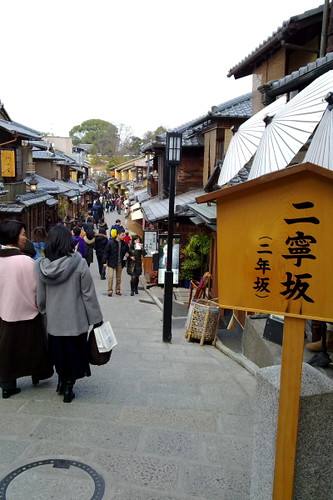
We had fun eating and shopping at Ninen zaka and Sannen zaka though, ate some matcha and chestnut cream puffs, friend bought a Japanese paper fan, and I bought some Kyoto pickles.

Inoda cafe is one of the oldest cafe in Kyoto that serves good breakfast. There is even a saying in Kyoto that one must always drink a cup of Inoda coffee before going to work!

Inoda's coffee is indeed good stuff. Without adding any sugar or milk, the coffee itself is fragrant and strong. It glided down my throat smoothly and the best part is that it did not leave a coffee after taste in my mouth after I finished the cup! But at a price of 500yen, S$7.80, it is not cheap yeh!
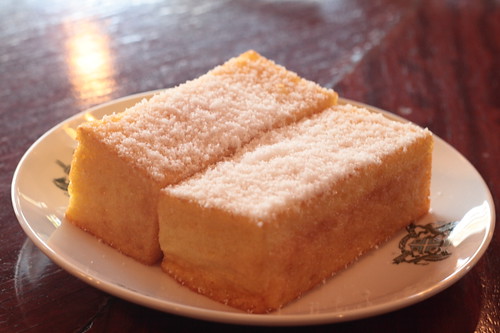
I've never liked French toast, but Inoda's French toast is extra-ordinary. This expensive plate of French toast costs 920yen, S$14.50, not exactly the kinda price you expect to pay for French toast. However it is all worth it. The toast is crispy but not hard on the outside, spongy and rich inside. It is not oily at all and tastes more like a cake than bread!

The beef sandwich is not cheap too at the price of 1730yen, S$27! But the steak is real juicy, a bit like medium rare, but without those gory blood! The bread is toasted crispy on the outside but soft inside. The bacons are crispy as well, but not dry at all. Overall, this is one good beef sandwich!
イノダコーヒ (Inoda) Official Website

We had fun eating and shopping at Ninen zaka and Sannen zaka though, ate some matcha and chestnut cream puffs, friend bought a Japanese paper fan, and I bought some Kyoto pickles.

Inoda cafe is one of the oldest cafe in Kyoto that serves good breakfast. There is even a saying in Kyoto that one must always drink a cup of Inoda coffee before going to work!

Inoda's coffee is indeed good stuff. Without adding any sugar or milk, the coffee itself is fragrant and strong. It glided down my throat smoothly and the best part is that it did not leave a coffee after taste in my mouth after I finished the cup! But at a price of 500yen, S$7.80, it is not cheap yeh!

I've never liked French toast, but Inoda's French toast is extra-ordinary. This expensive plate of French toast costs 920yen, S$14.50, not exactly the kinda price you expect to pay for French toast. However it is all worth it. The toast is crispy but not hard on the outside, spongy and rich inside. It is not oily at all and tastes more like a cake than bread!

The beef sandwich is not cheap too at the price of 1730yen, S$27! But the steak is real juicy, a bit like medium rare, but without those gory blood! The bread is toasted crispy on the outside but soft inside. The bacons are crispy as well, but not dry at all. Overall, this is one good beef sandwich!
イノダコーヒ (Inoda) Official Website
Tuesday, January 26, 2010
Anyhow walk in Japan - The trees are empty at Kiyomizu temple
The tourist-popular Kiyomizu temple is right up the hill, so you've got to walk up a pretty steep slope! You'll know you've reached the entrance of the temple when you see the big red "main gate".

There is this weird ear-shaped thingy on the red gate on both sides. It is said that you can hear people saying good stuff about you from afar if you listen carefully, or the other rumor is that if you place your ear next to it, you'll get better hearing! Some kinda fairy tale...
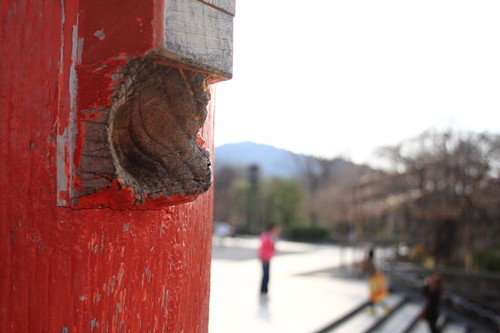
After paying 300yen, S$4.80, you can enter the main hall of the temple. Of course, just like the Japanese, cleanse your hands and mouth before you pray! The dragon vomiting the spring water doesn't look as friendly as our Merlion though...
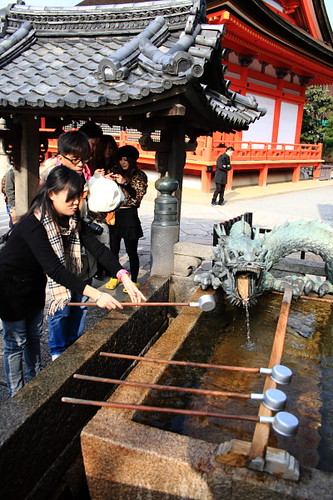
Kiyomizu temple's stage is THE place to be at to enjoy the whole hill of cherry blossoms or maple leaves. But of course all we saw were empty branches during the winter. Well, still a nice place to have a good view of Kyoto city and the Kyoto Tower!
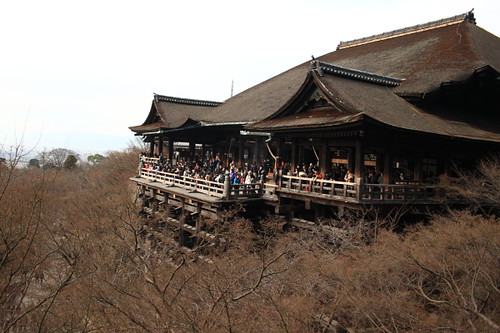
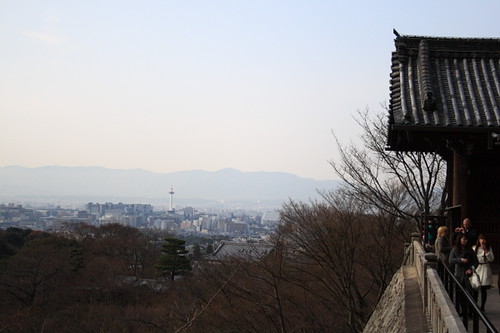
It is also said that not one nail is used when constructing the Kiyomizu temple stage, they just slotted in and out the planks of wood to form up the whole stage. Talk about ancient intelligence!
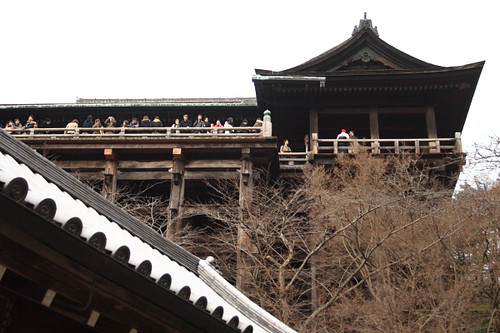
Next to the Kiyomizu temple stage is the Jishu Jinja. It is a popular shrine that Japanese gals go to pray for good love luck!
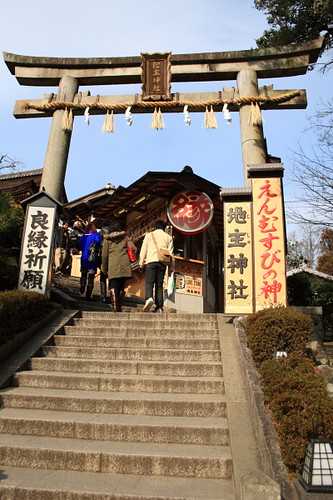
There are a pair of love stones at the shrine, with one at a corner and the other smacked in the middle of the road! It is said that if you were to close your eyes and still able to walk from one love stone to the other without fail, your love life will be just as smooth. But with the large number of tourists and locals crowding the road? Good luck.
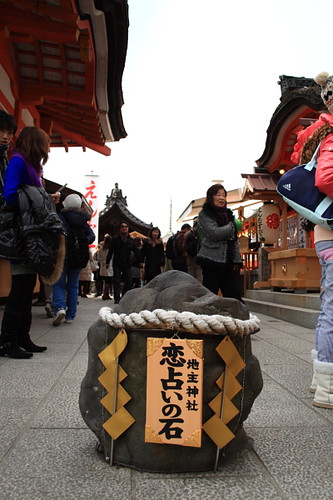
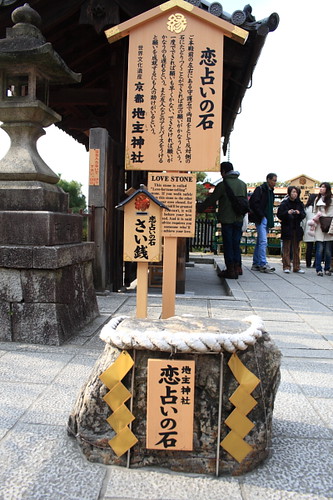
At one corner, Japanese gals were queuing up to pour water over a statue, which will bless their love! Well, pouring water does seem more environmental friendly than burning joss-sticks though!
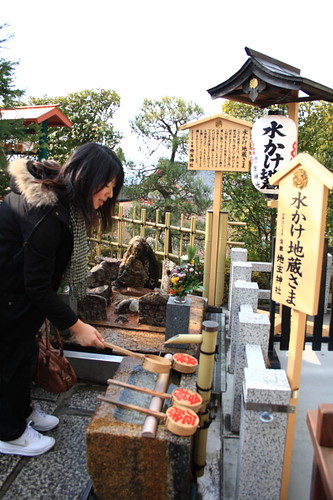
These three spring water streams must be the most queued-up area in the temple. They represent, from left to right, longevity, health and intelligence. Drink just from one stream and you'll be blessed, but if you're greedy and drink from all three, you'll be blessed 1/3 of each... geez... I didn't check up this piece of info BEFORE going and so I followed the rest and drank from the middle stream, thus blessing my health. It's not so bad, but the Singaporean in me actually thought that the middle one is for wealth, since so many Japanese drank from it...
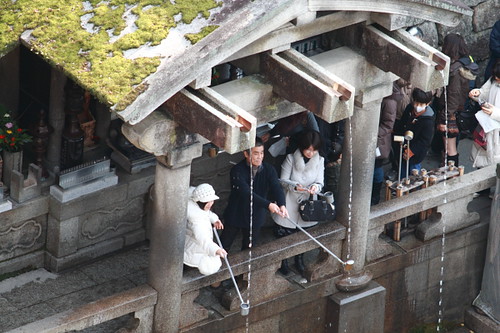
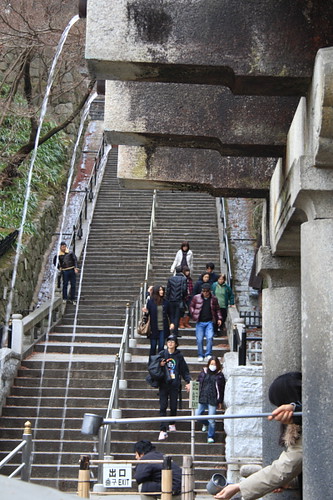
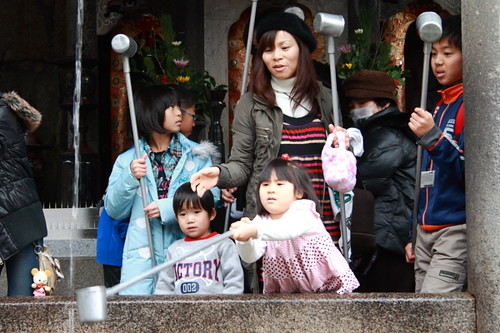
清水寺 (Kiyomizu dera) - Take the city bus till五條坂 (Gojou zaka) stop. After alighting from the bus, follow the crowd to cross the road and go up the slope.
清水寺 (Kiyomizu dera) Official Website
Read more (in Chinese) on "Go Travel with Cloudywind"!

There is this weird ear-shaped thingy on the red gate on both sides. It is said that you can hear people saying good stuff about you from afar if you listen carefully, or the other rumor is that if you place your ear next to it, you'll get better hearing! Some kinda fairy tale...

After paying 300yen, S$4.80, you can enter the main hall of the temple. Of course, just like the Japanese, cleanse your hands and mouth before you pray! The dragon vomiting the spring water doesn't look as friendly as our Merlion though...

Kiyomizu temple's stage is THE place to be at to enjoy the whole hill of cherry blossoms or maple leaves. But of course all we saw were empty branches during the winter. Well, still a nice place to have a good view of Kyoto city and the Kyoto Tower!


It is also said that not one nail is used when constructing the Kiyomizu temple stage, they just slotted in and out the planks of wood to form up the whole stage. Talk about ancient intelligence!

Next to the Kiyomizu temple stage is the Jishu Jinja. It is a popular shrine that Japanese gals go to pray for good love luck!

There are a pair of love stones at the shrine, with one at a corner and the other smacked in the middle of the road! It is said that if you were to close your eyes and still able to walk from one love stone to the other without fail, your love life will be just as smooth. But with the large number of tourists and locals crowding the road? Good luck.


At one corner, Japanese gals were queuing up to pour water over a statue, which will bless their love! Well, pouring water does seem more environmental friendly than burning joss-sticks though!

These three spring water streams must be the most queued-up area in the temple. They represent, from left to right, longevity, health and intelligence. Drink just from one stream and you'll be blessed, but if you're greedy and drink from all three, you'll be blessed 1/3 of each... geez... I didn't check up this piece of info BEFORE going and so I followed the rest and drank from the middle stream, thus blessing my health. It's not so bad, but the Singaporean in me actually thought that the middle one is for wealth, since so many Japanese drank from it...



清水寺 (Kiyomizu dera) - Take the city bus till五條坂 (Gojou zaka) stop. After alighting from the bus, follow the crowd to cross the road and go up the slope.
清水寺 (Kiyomizu dera) Official Website
Read more (in Chinese) on "Go Travel with Cloudywind"!
Monday, January 25, 2010
Anyhow walk in Japan - A hill-ful of tori gates
Fushimi Inari Shrine is a photographer's dreamland. It is so beautiful that it was even featured in the movie Memoirs of the Geisha. Can you imagine that? A hill full of red tori gates! And the best part? Fushimi Inari Shrine is just one train station away from Kyoto!
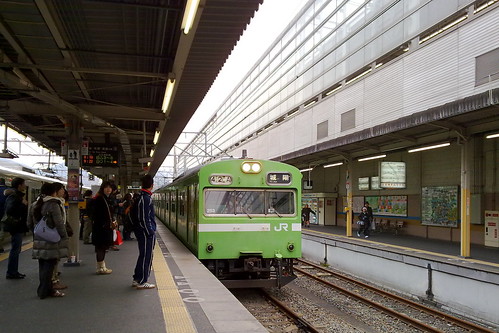
As usual, we need to cleanse ourselves before we pray in a Japanese temple/shrine. But wait! Before you start talking to the gods, telling them your wishes, please ring the bell to attract their attention!
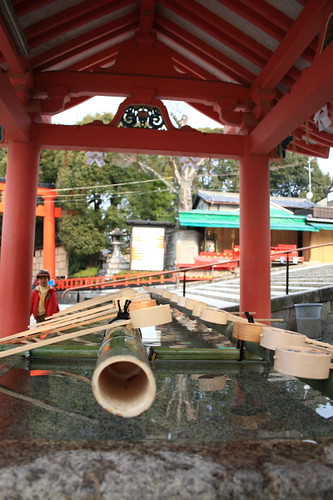
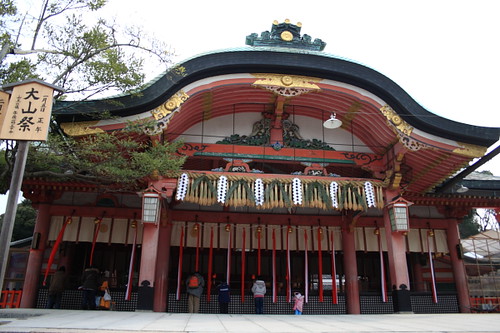
The Japanese believe that it is through a tori gate that they can enter the world of the gods and communicate with them. That is why you see a tori gate used a the main door of Japanese shrines. But why are there so many tori gates in Fushimi Inari Shrine? That's because these tori gates were built whenever someone donates big time to the shrine. On the tori gates, you can find the name of the donor on the left, and date of donation on the right. So just look at one whole hill of tori gates and imagine what vast amount has been donated at the Fushimi Inari Shrine!
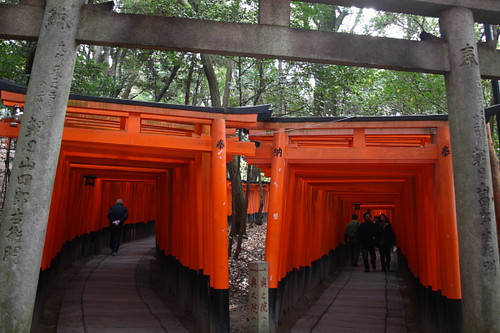
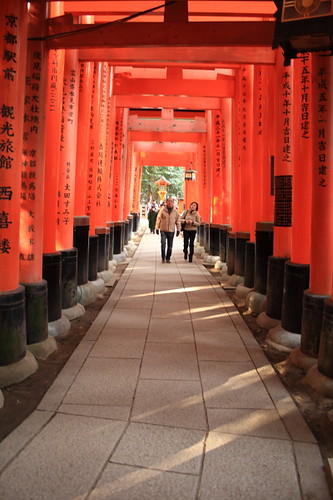
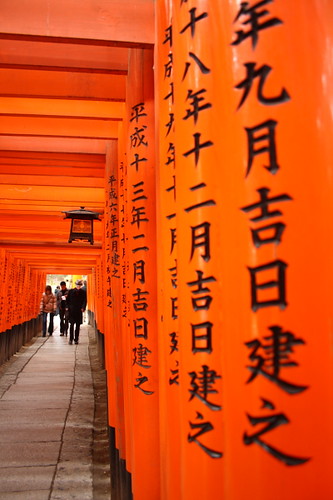
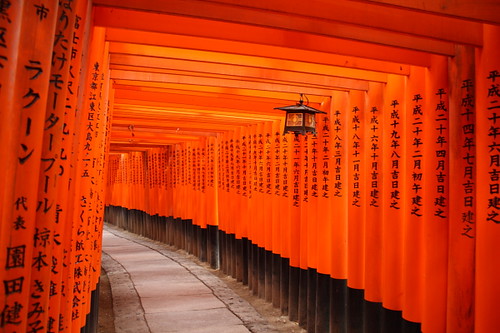
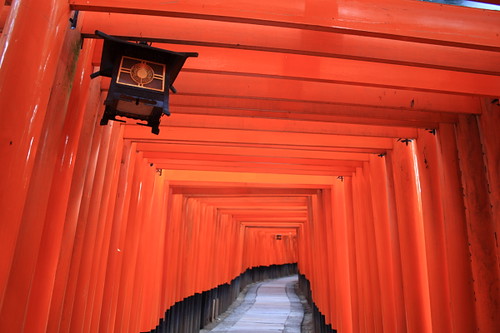
At the Fushimi Inari Shrine, there are also statues of fox. It is said that foxes are the messenger to carry your wishes to the gods!
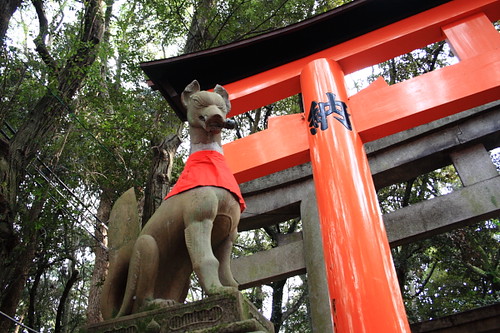

伏見稻荷大社 (Fushimi-Inari Taishi) - From Kyoto station, take the JR Nara line to Inari station.
伏見稻荷大社 (Fushimi-Inari Taishi) Official website
Read more (in Chinese) on "Go Travel with Cloudywind"!

As usual, we need to cleanse ourselves before we pray in a Japanese temple/shrine. But wait! Before you start talking to the gods, telling them your wishes, please ring the bell to attract their attention!


The Japanese believe that it is through a tori gate that they can enter the world of the gods and communicate with them. That is why you see a tori gate used a the main door of Japanese shrines. But why are there so many tori gates in Fushimi Inari Shrine? That's because these tori gates were built whenever someone donates big time to the shrine. On the tori gates, you can find the name of the donor on the left, and date of donation on the right. So just look at one whole hill of tori gates and imagine what vast amount has been donated at the Fushimi Inari Shrine!





At the Fushimi Inari Shrine, there are also statues of fox. It is said that foxes are the messenger to carry your wishes to the gods!


伏見稻荷大社 (Fushimi-Inari Taishi) - From Kyoto station, take the JR Nara line to Inari station.
伏見稻荷大社 (Fushimi-Inari Taishi) Official website
Read more (in Chinese) on "Go Travel with Cloudywind"!
Thursday, January 21, 2010
Anyhow walk in Japan - Eating green tea dessert in Gion
The huge red gate of the Yasaka Shrine, looking bright and magnificent in Gion.
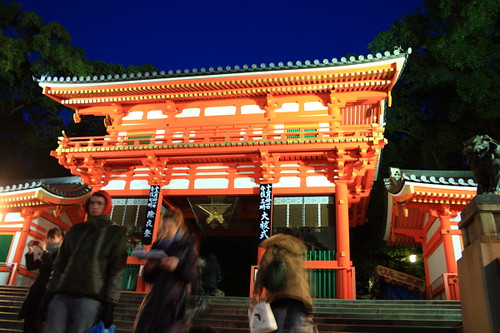
By the time we reached Yasaka Shrine, most stalls were closed except the one selling charms, and the shrine was pretty quiet.
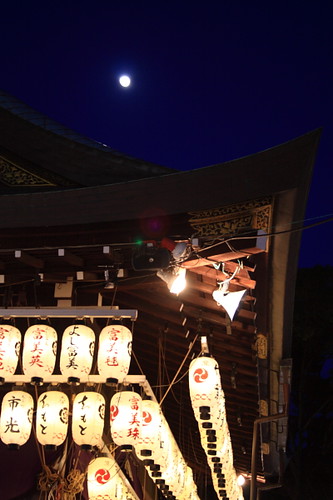
At the popular Hanami-koji street in Gion, we were surprised to find a huge group of tourists gathered outside a building that we supposed is some geisha headquarters, waiting patiently to take picture of a geisha. But all I see are old uncles and aunties coming out of it (and getting blinded by the flashlights). One of the aunties actually scolded the crowd in Japanese! Hahaha...

Not interested to wait for a geisha like the rest, we proceeded to the famous 茶寮都路里 (Tsujiri) dessert store. I ordered the winter limited edition set consisting of a bowl of matcha soba and a scope of matcha ice-cream at 1155yen, S$18.
The macha soba was not as fragrant as I have expected, in fact it tasted quite tasteless. However the matcha ice-cream was a different story. Now this is what I call green tea ice-cream! The green tea flavor was so strong and fragrant that I felt as if I was drinking tea rather than eating ice-cream!

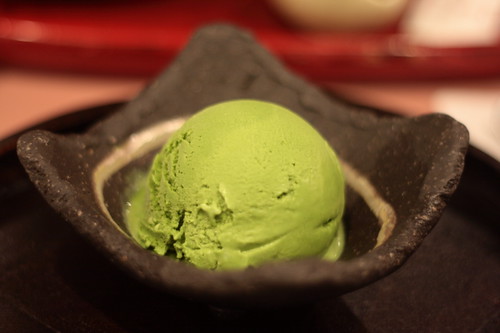
My friend ordered 味くらべ which is 997yen, S$15, consisting of わらび餅, 白玉だんご and matcha jelly. The 白玉だんご tastes kinda like our rice dumplings, chewy and tasteless, but when you add in the fragrant red beans and sweet matcha sauce, the whole white balls come to life! My friend didn't quite like the matcha jelly, especially the matcha whip cream which has a very strong milky taste (as she is not fond of milk), but both of us agreed that the わらび餅 is to-die-for, chewy and refreshing kuay with mashed bean coating!
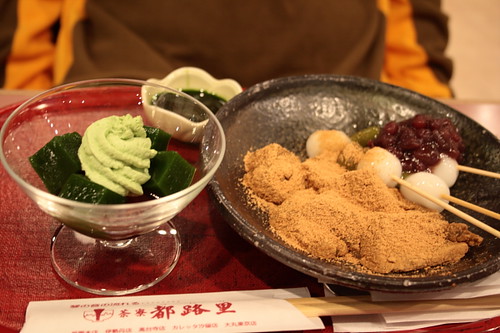
茶寮都路里 (Tsujiri) - Take city bus to Gion and walk down the main street.
茶寮都路里 (Tsujiri) Official Website
Read more (in Chinese) on "Go Travel with Cloudywind"!

By the time we reached Yasaka Shrine, most stalls were closed except the one selling charms, and the shrine was pretty quiet.

At the popular Hanami-koji street in Gion, we were surprised to find a huge group of tourists gathered outside a building that we supposed is some geisha headquarters, waiting patiently to take picture of a geisha. But all I see are old uncles and aunties coming out of it (and getting blinded by the flashlights). One of the aunties actually scolded the crowd in Japanese! Hahaha...

Not interested to wait for a geisha like the rest, we proceeded to the famous 茶寮都路里 (Tsujiri) dessert store. I ordered the winter limited edition set consisting of a bowl of matcha soba and a scope of matcha ice-cream at 1155yen, S$18.
The macha soba was not as fragrant as I have expected, in fact it tasted quite tasteless. However the matcha ice-cream was a different story. Now this is what I call green tea ice-cream! The green tea flavor was so strong and fragrant that I felt as if I was drinking tea rather than eating ice-cream!


My friend ordered 味くらべ which is 997yen, S$15, consisting of わらび餅, 白玉だんご and matcha jelly. The 白玉だんご tastes kinda like our rice dumplings, chewy and tasteless, but when you add in the fragrant red beans and sweet matcha sauce, the whole white balls come to life! My friend didn't quite like the matcha jelly, especially the matcha whip cream which has a very strong milky taste (as she is not fond of milk), but both of us agreed that the わらび餅 is to-die-for, chewy and refreshing kuay with mashed bean coating!

茶寮都路里 (Tsujiri) - Take city bus to Gion and walk down the main street.
茶寮都路里 (Tsujiri) Official Website
Read more (in Chinese) on "Go Travel with Cloudywind"!
Wednesday, January 20, 2010
7 ways that Kyoto beats Singapore
This is a post in response to Mr Brown's 7 ways that Taipei beats Singapore!
1. Kyoto restaurants don't charge you for tap water, but they serve you free real green tea
No, in Kyoto, they don't serve green tea brewed (is it right to use the word "brew" for the action of pouring 1 liter of hot water into a flask of 1 teabag?) from some bought-from-NTUC-during-special-offer green tea bags. Their green tea are brewed from green tea leaves and they do taste like green tea. And yes, it is free, and charging 20 cents for tap water is unheard of.
2. Kyoto buses arrive on time
In Kyoto, there is a time table at all their bus stops (or "stands" most of the time, where there is only a pole with sign), and unless it is during super peak (like when tourists from all over the world are there to see the maple leaves) where the buses might be late for up to 15 minutes (but wait, our minister said 15 minutes is considered acceptable according to New Immigrant Standard!), their buses all arrive on time. By the minute. For every single bus route, no matter how long or short.
And in order not to rub it into our world class public transport, I'm not even going to mention that their bus captains thank their passengers when the buses leave every bus stop.
3. Kyoto sales people apologise when they need to pass
It is a known fact that Japanese are super polite, but it is even more so in a shopping center in Kyoto. When a sales girl needs to cut your path, she'll apologise to you, not just try to squeeze through and only say "Excuse me" when you don't give way automatically. Oh, and the ultimate? When you walk past any sales girl, they will greet you and welcome you, not just stare into outer space. Actually sometimes I wonder whether the sales people in Singapore can actually see their (potential) customers...
4. Kyoto people don't put bags on their bus seats
There are things that Kyoto people just don't do on the bus. They don't eat and drink on the bus even though there is no big signs of "No eating/drinking or else we fine you". They don't talk loudly on the bus so that everybody knows where they intend to go for dinner. In fact, they don't even talk on their mobile phones on the bus! And the most obviously difference between a Kyoto and Singapore bus? Nobody puts any bag(s) on a bus seat.
5. Kyoto's roads are bicycle friendly and their riders don't try to kill themselves
Kyoto's roads have been there even earlier than when Raffles stepped onto Singapore but are still pretty well maintained, so bikers can ride safely without the fear of tripping or crashing into yet another road construction. Oh, their buses will not attempt to see how close can they go near the bikers without killing them.
On the other hand, while their bikers cycle on the pedestrian walkway at times, they do not try to sneak up and scare the pedestrians from behind, or ring their bells till the pedestrians give up the whole path to them. In fact, they tried to slow down when there is pedestrians ahead, something that is unheard of in Singapore.
6. Kyoto do not turn their historical buildings into gambling dens
Most of Kyoto's historical buildings are still there no matter how old they are, and no, they are not painted with ridiculously bright colors when they are restored. Some of the old buildings have been turned into cafes, restaurants or even hostels, but they still look as if a ninja will jump out of it any moment. And no, they don't turn a historical building into a gambling den just so that the landlord can earn from the rental.
7. Kyoto is really clean
I'm sorry that I've to state the obvious, but Kyoto is really clean. There is no dustbin anywhere on the street and Japanese are used to keeping their rubbish in their pockets/bags. They do not litter by nature, not because they are forced by fine, or because there is an army of cleaners to clean up after them.
So, do you know of anywhere in the world that beats Singapore in 7 ways?
1. Kyoto restaurants don't charge you for tap water, but they serve you free real green tea
No, in Kyoto, they don't serve green tea brewed (is it right to use the word "brew" for the action of pouring 1 liter of hot water into a flask of 1 teabag?) from some bought-from-NTUC-during-special-offer green tea bags. Their green tea are brewed from green tea leaves and they do taste like green tea. And yes, it is free, and charging 20 cents for tap water is unheard of.
2. Kyoto buses arrive on time
In Kyoto, there is a time table at all their bus stops (or "stands" most of the time, where there is only a pole with sign), and unless it is during super peak (like when tourists from all over the world are there to see the maple leaves) where the buses might be late for up to 15 minutes (but wait, our minister said 15 minutes is considered acceptable according to New Immigrant Standard!), their buses all arrive on time. By the minute. For every single bus route, no matter how long or short.
And in order not to rub it into our world class public transport, I'm not even going to mention that their bus captains thank their passengers when the buses leave every bus stop.
3. Kyoto sales people apologise when they need to pass
It is a known fact that Japanese are super polite, but it is even more so in a shopping center in Kyoto. When a sales girl needs to cut your path, she'll apologise to you, not just try to squeeze through and only say "Excuse me" when you don't give way automatically. Oh, and the ultimate? When you walk past any sales girl, they will greet you and welcome you, not just stare into outer space. Actually sometimes I wonder whether the sales people in Singapore can actually see their (potential) customers...
4. Kyoto people don't put bags on their bus seats
There are things that Kyoto people just don't do on the bus. They don't eat and drink on the bus even though there is no big signs of "No eating/drinking or else we fine you". They don't talk loudly on the bus so that everybody knows where they intend to go for dinner. In fact, they don't even talk on their mobile phones on the bus! And the most obviously difference between a Kyoto and Singapore bus? Nobody puts any bag(s) on a bus seat.
5. Kyoto's roads are bicycle friendly and their riders don't try to kill themselves
Kyoto's roads have been there even earlier than when Raffles stepped onto Singapore but are still pretty well maintained, so bikers can ride safely without the fear of tripping or crashing into yet another road construction. Oh, their buses will not attempt to see how close can they go near the bikers without killing them.
On the other hand, while their bikers cycle on the pedestrian walkway at times, they do not try to sneak up and scare the pedestrians from behind, or ring their bells till the pedestrians give up the whole path to them. In fact, they tried to slow down when there is pedestrians ahead, something that is unheard of in Singapore.
6. Kyoto do not turn their historical buildings into gambling dens
Most of Kyoto's historical buildings are still there no matter how old they are, and no, they are not painted with ridiculously bright colors when they are restored. Some of the old buildings have been turned into cafes, restaurants or even hostels, but they still look as if a ninja will jump out of it any moment. And no, they don't turn a historical building into a gambling den just so that the landlord can earn from the rental.
7. Kyoto is really clean
I'm sorry that I've to state the obvious, but Kyoto is really clean. There is no dustbin anywhere on the street and Japanese are used to keeping their rubbish in their pockets/bags. They do not litter by nature, not because they are forced by fine, or because there is an army of cleaners to clean up after them.
So, do you know of anywhere in the world that beats Singapore in 7 ways?
Anyhow walk in Japan - New year in Nishiki Market
To understand how a country's people spend their New Year is to have a visit to their markets, which is why it was a really right time for us to take a walk at Kyoto's Nishiki Market!
And just like our Chinatown New Year Pasar Malam, it was super crowded!
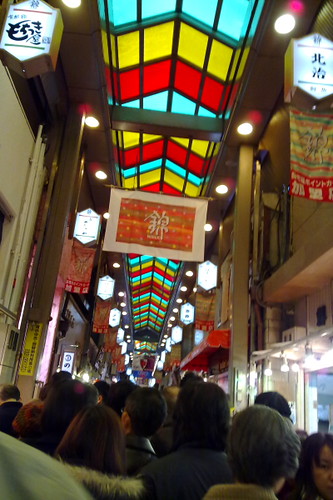
While we are complaining how expansive the seafood will be during our Chinese New Year, the Japanese's auspicious fish cost them like 4,000yen or S$63!
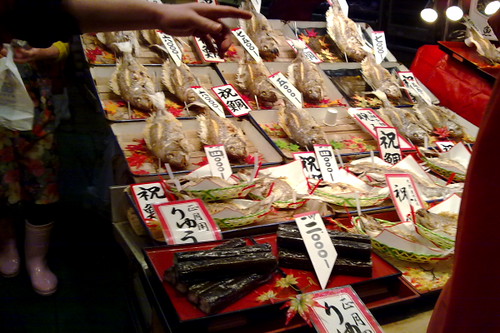
The Japanese hang ornaments on their doors during their New Year like we do, but instead of some o-bian gold ingots, red fire crackers and God of Fortune that try to act cute, they hang recyclable and environmental friendly leaves and oranges.
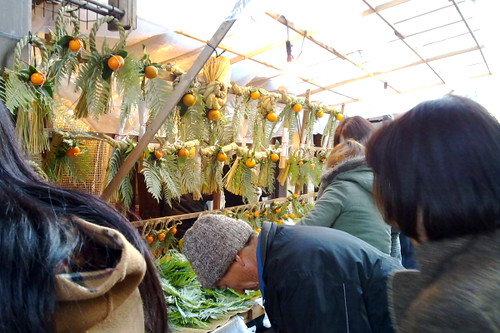
Here are some New Year kuay that the Japanese will pray with during the New Year then eat them up on the eleventh of January's 鏡開きの日.
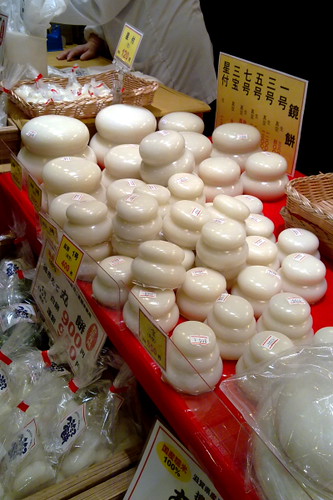
Kyoto pickles are famous and so you'll expect to see big tubs of all sorts of pickles in the Nishiki Market. However they're not going to last through more days traveling in Japan before back to Singapore so I have to forget about the idea of buying some back!

Friend took a picture of a group of guests in the little Japanese cafe in Nishiki Market before we got ourselves a table.

I ordered a bowl of red bean soup with BBQ mochi, which was really delicious! The red beans are big and tasty (meaning not just sweet, but also fragrant) and the mochi was crispy on the outside and chewy inside. The already very fragrant soup has gotten more character due to the charcoal taste from the BBQ mochi.

There's a shop that sells just rice crackers but they have lots of different flavors and they'll BBQ it before serving to you.
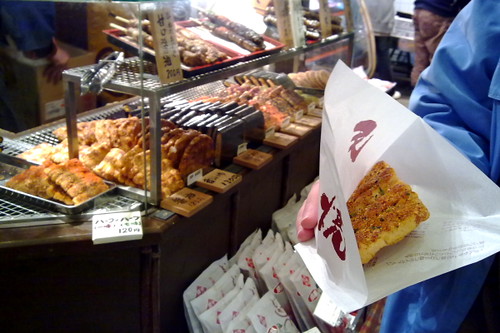
Kyoto tofu is famous and so we have to try out the tofu donuts and tofu ice-cream. The little tofu donuts were crispy on the outside and firm but not too hard inside, and very fragrant. It was 250yen, S$4 for 10, but we snapped them all up anyway!

On the other hand, maybe due to the strong taste of the tofu donuts, the tofu ice-cream didn't taste as strong and as good.

Right at the end of Nishiki Market is Nishiki Tenmangu shrine. Japanese students will pray here before exams because the shrine is a memorial of a very intelligent guy who used to serve the king.
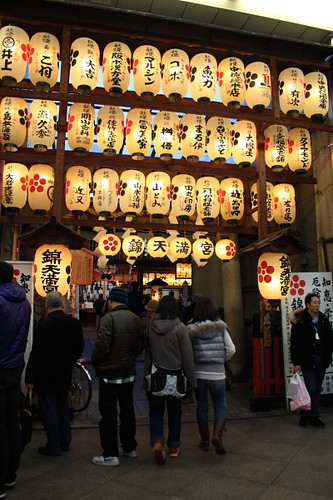

It is said that if you touch the Nishiki Tenmangu shrine's bull's head, you'll become cleverer, and if you touch its body, you'll become healthier!

Inside Nishiki Tenmangu is a spring water point known as the 錦の水. Hey, we even saw an old uncle collecting bottles of it, so we couldn't be too wrong drinking a few big mouthfuls!
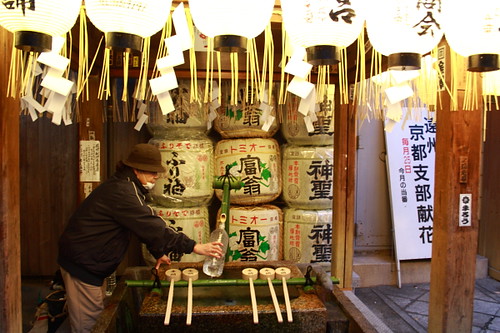
锦市场 (Nishiki Market) - Take city bus to 四条大仓, from the bus stop which is in front of Daimaru, walk down and Nishiki Market is hidden somewhere in a street inside the alleys.
锦市场 (Nishiki Market) Official Website
Read more (in Chinese) on "Go Travel with Cloudywind"!
And just like our Chinatown New Year Pasar Malam, it was super crowded!

While we are complaining how expansive the seafood will be during our Chinese New Year, the Japanese's auspicious fish cost them like 4,000yen or S$63!

The Japanese hang ornaments on their doors during their New Year like we do, but instead of some o-bian gold ingots, red fire crackers and God of Fortune that try to act cute, they hang recyclable and environmental friendly leaves and oranges.

Here are some New Year kuay that the Japanese will pray with during the New Year then eat them up on the eleventh of January's 鏡開きの日.

Kyoto pickles are famous and so you'll expect to see big tubs of all sorts of pickles in the Nishiki Market. However they're not going to last through more days traveling in Japan before back to Singapore so I have to forget about the idea of buying some back!

Friend took a picture of a group of guests in the little Japanese cafe in Nishiki Market before we got ourselves a table.

I ordered a bowl of red bean soup with BBQ mochi, which was really delicious! The red beans are big and tasty (meaning not just sweet, but also fragrant) and the mochi was crispy on the outside and chewy inside. The already very fragrant soup has gotten more character due to the charcoal taste from the BBQ mochi.

There's a shop that sells just rice crackers but they have lots of different flavors and they'll BBQ it before serving to you.

Kyoto tofu is famous and so we have to try out the tofu donuts and tofu ice-cream. The little tofu donuts were crispy on the outside and firm but not too hard inside, and very fragrant. It was 250yen, S$4 for 10, but we snapped them all up anyway!

On the other hand, maybe due to the strong taste of the tofu donuts, the tofu ice-cream didn't taste as strong and as good.

Right at the end of Nishiki Market is Nishiki Tenmangu shrine. Japanese students will pray here before exams because the shrine is a memorial of a very intelligent guy who used to serve the king.


It is said that if you touch the Nishiki Tenmangu shrine's bull's head, you'll become cleverer, and if you touch its body, you'll become healthier!

Inside Nishiki Tenmangu is a spring water point known as the 錦の水. Hey, we even saw an old uncle collecting bottles of it, so we couldn't be too wrong drinking a few big mouthfuls!

锦市场 (Nishiki Market) - Take city bus to 四条大仓, from the bus stop which is in front of Daimaru, walk down and Nishiki Market is hidden somewhere in a street inside the alleys.
锦市场 (Nishiki Market) Official Website
Read more (in Chinese) on "Go Travel with Cloudywind"!
Tuesday, January 19, 2010
Anyhow walk in Japan - Eat our way to Togetsukyo
Just at the exit of Bamboo Grove, there are a couple of eating shops selling ice-cream (Japanese just love their ice-creams, even in Winter!), BBQ yam cakes and noodles etc.
We decided to warm our stomach with some soup soba at this 三忠 tofu stall, run by a Japanese aunty. The prices of her dishes are pretty reasonable, mostly at 300yen, S$4.80.

This simple bowl of age-soba is simply delicious. The soba is just nice, not overcooked till too soft as in some of Singapore's chain Japanese restaurants. The age or tofu skin is sweet and fragrant, and the soup! You can tell that it has been brewed for quite some time!
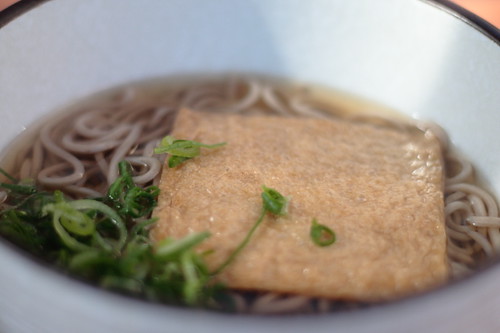
Arashiyama is famous for its tofu, so of course we need to have tofu here! The soup tofu is just a little piece of tofu in a dish of soy sauce, so that one can taste the original taste of the tofu. You just can't do that in Singapore with our tasteless tofus...

After a meal of tofu and soba, we passed by a sakura kuay shop, and the kuay looked so unique that we just have to buy one piece. It is actually sticky rice with sakura paste inside and the rice itself wrapped in two pieces of sakura leaves. The taste? Refreshing, flowery and sweet!

Then we came across a very interesting shop that sells all kinds of handmade woven decorative items. Only one word to describe all the items in the shop - Kawaii~~
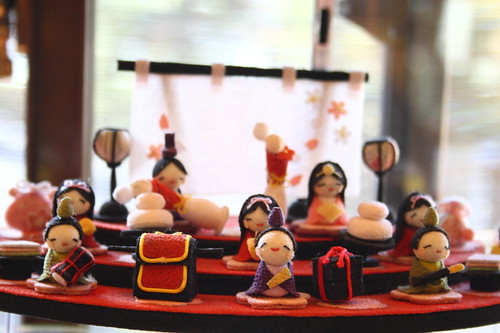
They sell a large variety of soft woven sushi that look just as delicious!

Not a sushi fan? How about some western cakes or Japanese kuays then?
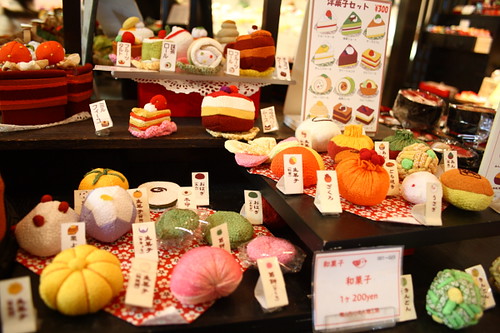
After seeing so many like-real sushi and cakes, we were hungry again so we bought a piece of fried minced beef potato cake. It was freshly fried and tasted good, but we were not impressed as we just had a very out-of-the-world tonkatsu dinner the previous night!

Finally we reached Togetsukyo! The bridge was crowded with tourists taking photographs and rickshaw pullers getting customers.
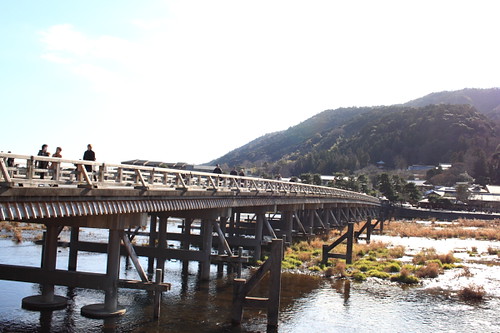

On one side of Togetsukyo, there is a row of fast rapid running down the river. On the other side, the river was so calm the bottom could be seen! How strange!

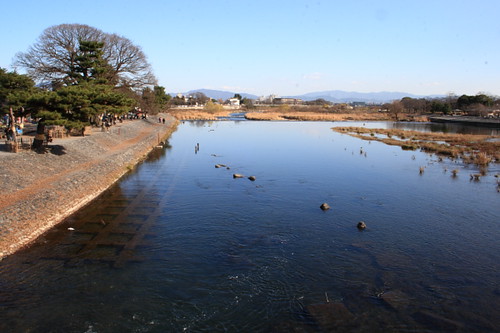
渡月桥 (Togetsukyo) - After coming out of the tram station, just turn left and walk straight.
Read more (in Chinese) on "Go Travel with Cloudywind"!
We decided to warm our stomach with some soup soba at this 三忠 tofu stall, run by a Japanese aunty. The prices of her dishes are pretty reasonable, mostly at 300yen, S$4.80.

This simple bowl of age-soba is simply delicious. The soba is just nice, not overcooked till too soft as in some of Singapore's chain Japanese restaurants. The age or tofu skin is sweet and fragrant, and the soup! You can tell that it has been brewed for quite some time!

Arashiyama is famous for its tofu, so of course we need to have tofu here! The soup tofu is just a little piece of tofu in a dish of soy sauce, so that one can taste the original taste of the tofu. You just can't do that in Singapore with our tasteless tofus...

After a meal of tofu and soba, we passed by a sakura kuay shop, and the kuay looked so unique that we just have to buy one piece. It is actually sticky rice with sakura paste inside and the rice itself wrapped in two pieces of sakura leaves. The taste? Refreshing, flowery and sweet!

Then we came across a very interesting shop that sells all kinds of handmade woven decorative items. Only one word to describe all the items in the shop - Kawaii~~

They sell a large variety of soft woven sushi that look just as delicious!

Not a sushi fan? How about some western cakes or Japanese kuays then?

After seeing so many like-real sushi and cakes, we were hungry again so we bought a piece of fried minced beef potato cake. It was freshly fried and tasted good, but we were not impressed as we just had a very out-of-the-world tonkatsu dinner the previous night!

Finally we reached Togetsukyo! The bridge was crowded with tourists taking photographs and rickshaw pullers getting customers.


On one side of Togetsukyo, there is a row of fast rapid running down the river. On the other side, the river was so calm the bottom could be seen! How strange!


渡月桥 (Togetsukyo) - After coming out of the tram station, just turn left and walk straight.
Read more (in Chinese) on "Go Travel with Cloudywind"!
Subscribe to:
Posts (Atom)